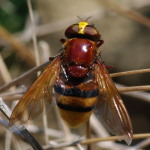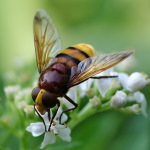Phylum Arthropoda (Arthropods) ➔ Subphylum Hexapoda (Hexapods) ➔ Class Insecta (Insects) ➔ Order Diptera (True flies) ➔ Family Syrphidae (Hoverflies)
Volucella zonaria (Poda, 1761)
Hornissenschwebfliege Hornet Mimic Hoverfly
Synonyms and other combinations:
Conops bifasciatus Scopoli, 1763 | Musca valentina Müller, 1766 | Syrphus bifasciatus Panzer, 1792 | Volucella beckeri Goot, 1961 | Volucella fasciata Herrich-Schaffer, 1829 | Volucella fasciata Verrall, 1901 | Volucella radicum Schrank, 1803 |
Classification:
Volucella zonaria belongs to the subfamily Eristalinae, tribe Volucellini.Distribution:
From Poland south to the Mediterranean (including islands) and North Africa; from Britain (southern England) eastwards through central and southern Europe (Italy, the former Yugoslavia, Greece) into Turkey and European parts of Russia and on through Siberia to the Pacific; Iran; Mongolia.Habitat:
Forest/open ground, often in parks and gardens.Description:
Large hoverfly with a body length of 18 - 22 mm; thorax glossy reddish brown; abdomen black with reddish yellow horizontal stripes on tergits 2 and 3; abdominal segment 4 completely yellow.In rare cases the thoracic dorsum may also be black and the light band on the third segment may be reduced to 2 small, lateral spots.
Biology:
The Hornet Mimic Hoverfly Volucella zonaria flies in one generation from mid of June to November. This species which is widespread especially in southern Europe is one of the expansive migrants.The males hover in sunny and sheltered areas some meters above the ground. Adults visit for feeding on nectar and pollen the flowers of many different plants, such as Achillea, Buddleja, Carduus, Centaurea, Cirsium, Clematis, Hedera, Knautia, Ligustrum, Rosa canina, Rubus, Sambucus, Solidago, Thymus... .
The saprophagous larvae of Volucella zonaria develop in nests of social wasps above and below ground. Larvae of the species were found in nests of the German Wasp, the Common Wasp and of hornets. They live at the bottom of the nest and feed on waste and dead host larvae. For pupation the Volucella larvae leave the wasp nest.
References, further reading, links:
- Pape T. & Thompson F.C. (eds) (2017). Systema Dipterorum (version 2.0, Jan 2011). In: Species 2000 & ITIS Catalogue of Life, 2017 Annual Checklist (Roskov Y., Abucay L., Orrell T., Nicolson D., Bailly N., Kirk P.M., Bourgoin T., DeWalt R.E., Decock W., De Wever A., Nieukerken E. van, Zarucchi J., Penev L., eds.). Digital resource at www.catalogueoflife.org/annual-checklist/2017. Species 2000: Naturalis, Leiden, the Netherlands. ISSN 2405-884X.
- Gerald Bothe: Bestimmungsschlüssel für die Schwebfliegen (Diptera, Syrphidae) Deutschlands und der Niederlande, DJN, 1984, ISBN 3-923376-07-3
- M.C.D.Speight: Species Accounts of European Syrphidae (Diptera), Glasgow 2011, Syrph the Net, the database of European Syrphidae, vol. 65, 285 pp., Syrph the Net publications, Dublin.
- Menno Reemer, Willem Renema, Wouter van Steenis, Theo Zeegers, Aat Barendregt, John T. Smit, Mark P. van Veen, Jeroen van Steenis, Laurens van der Leij: De Nederlandse Zweefvliegen (Diptera: Syrphidae), Nederlandse Fauna 8, 2009.
- Speight, M.C.D. & Sarthou, J.-P. (2014) StN keys for the identification of the European species of various genera of Syrphidae (Diptera) 2014 / Clés StN pour la détermination des espèces Européennes de plusieurs genres des Syrphidae (Diptères) 2014. Syrph the Net, the database of European Syrphidae, Vol. 80, 125 pp, Syrph the Net publications, Dublin
- Anasimyia interpuncta
- Anasimyia transfuga
- Baccha elongata
- Blera fallax
- Brachyopa sp.
- Brachypalpoides lentus
- Brachypalpus laphriformis
- Brachypalpus sp.
- Brachypalpus valgus
- Ceriana conopsoides
- Ceriana vespiformis
- Chalcosyrphus femoratus
- Chalcosyrphus nemorum
- Chalcosyrphus valgus
- Cheilosia albipila
- Cheilosia albitarsis
- Cheilosia chrysocoma
- Cheilosia illustrata
- Cheilosia pagana
- Cheilosia scutellata
- Cheilosia sp.
- Cheilosia variabilis
- Chrysogaster sp.
- Chrysotoxum bicinctum
- Chrysotoxum fasciatum
- Chrysotoxum festivum
- Chrysotoxum verralli
- Criorhina berberina
- Dasysyrphus albostriatus
- Dasysyrphus sp.
- Dasysyrphus tricinctus
- Didea fasciata
- Didea intermedia
- Didea sp.
- Epistrophe diaphana
- Epistrophe eligans
- Epistrophe flava
- Epistrophe grossulariae
- Epistrophe melanostoma
- Epistrophe melanostoma/nitidicollis
- Epistrophella euchroma
- Episyrphus balteatus
- Eristalinus aeneus
- Eristalinus megacephalus
- Eristalinus taeniops
- Eristalis arbustorum
- Eristalis interrupta
- Eristalis intricaria
- Eristalis lineata
- Eristalis pertinax
- Eristalis rupium
- Eristalis similis
- Eristalis sp.
- Eristalis tenax
- Eumerus purpurariae
- Eumerus sp.
- Eupeodes corollae
- Eupeodes luniger
- Eupeodes sp.
- Eurimyia lineata
- Ferdinandea cuprea
- Hammerschmidtia ferruginea
- Helophilus hybridus
- Helophilus pendulus
- Helophilus sp.
- Helophilus trivittatus
- Ischiodon aegyptius
- Leucozona glaucia
- Leucozona laternaria
- Leucozona lucorum
- Melangyna lasiophthalma
- Melangyna quadrimaculata
- Melangyna umbellatarum
- Melanogaster sp.
- Melanostoma scalare
- Meligramma triangulifera
- Meliscaeva cinctella
- Merodon ambiguus
- Merodon avidus
- Merodon equestris
- Merodon moenium
- Merodon obscuritarsis
- Merodon sp.
- Microdon analis/major
- Microdon mutabilis/myrmicae
- Myathropa florea
- Myolepta dubia
- Orthonevra sp.
- Paragus sp.
- Parasyrphus lineolus
- Parhelophilus sp.
- Pipiza austriaca
- Pipiza bimaculata
- Pipiza fenestrata
- Pipiza quadrimaculata
- Pipiza sp.
- Platycheirus rosarum
- Platycheirus sp.
- Rhingia campestris
- Rhingia rostrata
- Scaeva albomaculata
- Scaeva pyrastri
- Scaeva selenitica
- Sericomyia lappona
- Sericomyia silentis
- Sphaerophoria rueppelli
- Sphaerophoria scripta
- Sphaerophoria sp.
- Sphegina sp.
- Spilomyia saltuum
- Syritta pipiens
- Syrphus ribesii
- Syrphus sp.
- Syrphus vitripennis
- Temnostoma bombylans
- Temnostoma meridionale
- Temnostoma vespiforme
- Tropidia scita
- Volucella bombylans
- Volucella inanis
- Volucella pellucens
- Volucella zonaria
- Xanthogramma citrofasciatum
- Xanthogramma pedissequum
- Xylota segnis
- Xylota sp.
- Xylota sylvarum

